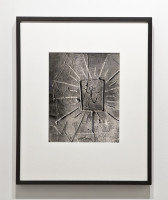JTF (just the facts): A total of 7 black and white photographs and two tapestries, the photographs framed in black/grey and matted, and all of the works are hung against white walls in the main gallery space, the entry, and the office area. The photographs are gelatin silver prints, made between 1933 and 1956. Physical sizes range from roughly 12×9 to 20×16. The two tapestries are made of flat-weave wool, and were executed in 1968 by Atelier Yvette Cauquil-Prince. The two are sized 119×58 and 110×54 respectively. (Installation shots below.)
Comments/Context: When we think of Brassaï‘s many iconic images of nocturnal Paris, whether they depict the bars and the dance halls, the misty bridges and the whorehouses, or the hoodlums and the streetwalkers, one of the things that ties them all together is a palpable sense of dark energy. His vision of that place (and time) is brimming with primal humanity, and as we follow him as he wanders the streets at night, he forces us to embrace the varied personalities of the city in all their rich and vital roughness.
Brassaï‘s long standing interest in Parisian graffiti might seem to be an odd complement to the brash life simmering in his nighttime vignettes, but his portrait-like images of scratchings and wall carvings discovered over his entire career (starting in the 1930s and continuing through the mid 1950s) capture many of the same essential human motives. Like ancestral cave paintings, these anonymous artworks traffic in a parade of urges, remembrances, and communications – love, sex, death, masks and faces, animals, and other magical talismans – and do so with an unadorned authenticity that crackles with life.
Brassaï‘s graffiti pictures have been published/shown in a multitude of books and exhibitions in the years since their making, and their power seems undiminished by the passing time. While Picasso was a fan of their primitive inventiveness as early as the mid-1940s, it takes very few steps to connect these photographs to Haring, Basquiat, and other more contemporary artists – their messages are durably universal, and their methods remain a source of inspiration to artists of all kinds.
Surprisingly, the fascinations of this show aren’t entirely grounded in Brassaï‘s original graffiti photographs, but in a little known project he undertook in 1968 to turn them into tapestries. Starting with his archive of graffiti prints, he made paper collages for a total of 7 large scale murals, which were then turned into cartoons/loom instructions, and ultimately into wool tapestries made by Yvette Cauquil-Prince (who worked with Picasso, Chagall, Miró, Kandinsky, Klee, and Calder, among others), two of which are on display here.
If Brassaï‘s hand-crafted translation of photography into another output medium sounds familiar, it should – this same artistic discussion continues to dominate much of contemporary photography in the 21st century. And even though Brassaï was doing his multi-media experimentation in the late 1960s, his process and mindset are still remarkably relevant to the “what is a photograph” debate going on now. His methods were of the analog, cut-and-paste variety, but the parallels to digital/software encoding and inkjet printing on any number of substrates are undeniably there. Just ask Brendan Fowler and Lisa Oppenheim, who have both recently explored the connections between photography and woven/sewn textiles.
While Brassaï’s photographs almost always honed in on a single graffiti form, his tapestries overflow with small motifs and icons, literally covering the entire surface of the wall. Both works (one in a mix of black, brown, and grey, the other mimicking the colors of night in blue, purple, and black) are dominated by the central outline of a stick figure bird woman, and flanked by dozens of supporting visuals. Hearts (some whole, some broken) and initials dominate one tapestry, while skulls, hourglass figures, and arrows have been introduced into the symbolic mix of the other; while many of the same source images are repeated in both tapestries (some of which are shown as black and white prints nearby), they feel like evolving variants, with Brassaï’s ideas morphing with each new iteration. And if serial reworking and image iteration ring a contemporary bell (as they should), we’re brought back to just how prescient and forward thinking these genre-defying works from half a century ago really were.
So not only are these Brassaï tapestries extremely rare (and valuable), they provide important historical context for many of the aesthetic choices being made today. I think we’re often confused into thinking that the issues we’re grappling with in a digital photographic world are somehow unprecedented, and that the solutions contemporary artists are coming up with are unique. Smart shows like this one abruptly dispel those myths, and ground us in the realities of art history – these works, which faced many of the same challenges we face today, exist and have a story to tell. Even if we are reinventing the wheel again and again because we have forgotten what came before, the rediscovery of superlative examples like these allows us to draw connections that enrich our understanding, forcing us to both acknowledge the brilliance of the past and be more humble in our declarations about the originality of the present.
Collector’s POV: The works in this show are priced as follows. The photographs range from $17000 to $50000, while the two tapestries are POR. Works by Brassaï are readily available in the secondary markets, with prices generally ranging from roughly $2000 to $60000, with a few vintage outliers in six figures.
More information available at: https://collectordaily.com/brassai-language-of-the-wall-the-tapestries-1968-higher-pictures/

